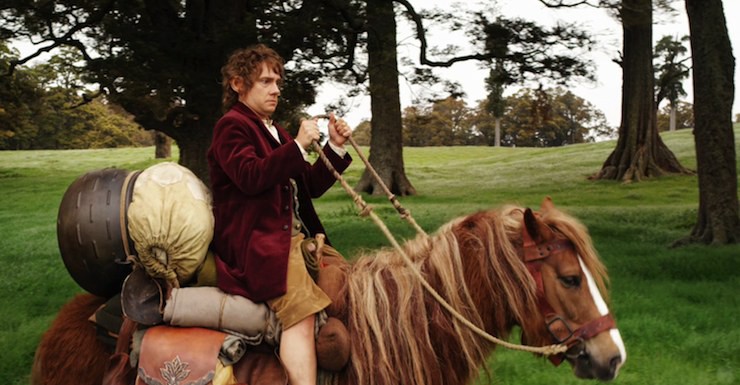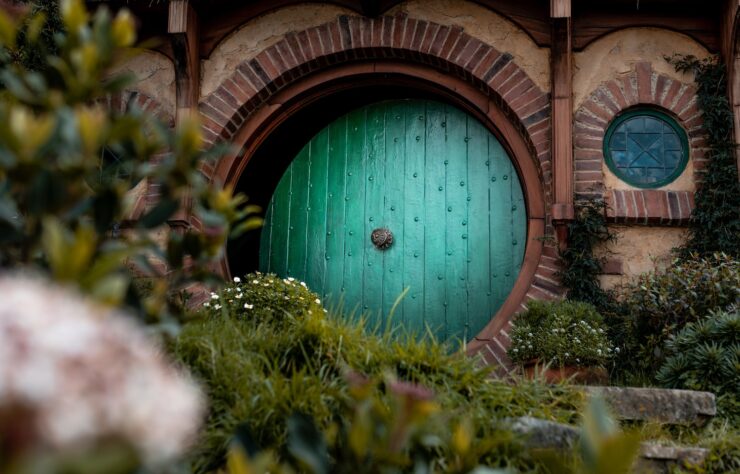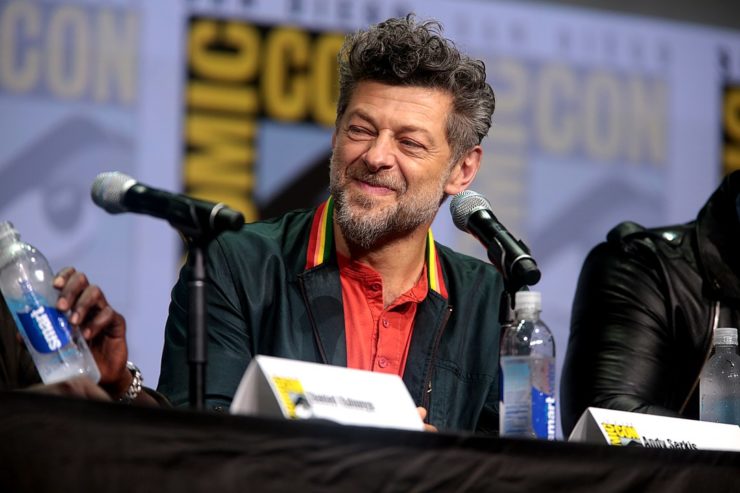Please enjoy this encore post on The Hobbit from a horse-lover’s perspective, originally published March 2016.
A certain degree of affection for Tolkien and his works is almost a geek shibboleth, so I’ve spent a fair amount of time feeling bad about my almost total indifference towards The Lord of the Rings. I enjoyed Bilbo’s eleventy-first birthday party, but absolutely could not tolerate the Mines of Moria, or whatever it was they had to trudge through for, like, ever to get to I don’t even know where because I gave up. I never even tried the rest of the trilogy. I thought the movies were OK, but kind of long. I don’t think this makes me a bad geek. I’ve read Diana Wynne Jones’s description of Tolkien as a lecturer at Oxford, and I don’t think I’m missing that much.
Out of respect for the traditions of my people, I have read The Hobbit, and read it to my children. It’s an enjoyable enough piece of light entertainment. I understand that the work has found an audience of devoted fans. But I am a reader with different priorities—and JRR Tolkien is almost unforgivably bad at horses. Tolkien will go on to do a better job with horses in later books: Samwise and Frodo named their ponies, and Frodo tries to rescue his from some trolls; Shadowfax is pretty cool; the Riders of Rohan seem like they would pass muster with the Pony Club. The Hobbit, however, is an equine abattoir.
In a hole in the ground, there lived a hobbit and he didn’t own a pony. I can tell because Tolkien provided a tolerably thorough description of the hobbit’s house and the hill in which it is embedded, and he didn’t mention the paddock, the grain shed, the bales of hay, the buckets and wheelbarrows, Bilbo’s devotion to maintaining his fencing, or the faint but pervasive smell of leather and sweat. Bilbo is also averse to adventures, which his family regards as disreputable. This strongly suggests that he’s not galloping over hill and dale jumping over sheep, or traveling long distances, or routinely engaging in other activities which would make the care and maintenance of a pony a worthwhile investment. Bilbo is not entirely a Hobbit of Leisure—he does his own cooking and washing up—but he doesn’t seem to be a Hobbit farmer either, so he doesn’t need a pony to pull his plow. Hobbits usually go barefoot because, Tolkien informs us, their feet are very sturdy. I have concerns about whether or not a Hobbit’s feet are really hardy enough to withstand having their toes trodden on by a shod pony. I concede that it’s possible that Hobbits do OK with that despite my concerns. But nonetheless, Bilbo neither owns nor routinely rides a pony, and Tolkien never tried to claim that he did.
So what is he doing riding off to the Lonely Mountains on one? Ponies climb up and down mountains every day. Turning a horse (or pony) out on mountainous pasture is a decent way to build some muscle before putting an animal into training or work. However, there are some issues that need to be taken into consideration when combining ponies and long rides to (and eventually up) mountains, and the first of these is Bilbo. Our aspiring burglar undergoes a significant transformation in the opening chapters of The Hobbit, but he doesn’t have time to pack his pocket handkerchiefs, let alone take riding lessons.
Historically, riding lessons were a luxury not available—or even considered necessary—by many people who rode. But historically, one began one’s riding career with short rides in early childhood and progressed slowly from that point. One didn’t borrow a cloak and hood and then hop on a horse and ride far into the Lone-lands from May into June. Stirrups offer some further complications for hobbits. Stirrups aren’t an absolute requirement for riding. If you’re not trying to shoot arrows from horseback, you can get by without them. A substantial school of thought insists that beginning riders should not use reins or stirrups until they’ve developed a strong seat. Hobbits who don’t wear shoes might have a hard time finding stirrups that they can comfortably shove their leathery toes through. The major benefit to stirrups is that, with a little practice, they can help mitigate concussive forces. Whether he’s using stirrups or not, Bilbo would be too crippled to walk (and acutely aware of all of the seams in his trousers) by the end of the first day.

Tolkien is also unclear on the number of ponies involved in the dwarves’ treasure-retrieval project. There are thirteen dwarves, plus Bilbo and Gandalf. At their departure from the Inn in Hobbiton, the ponies are laden with “baggages, packages, parcels, and paraphernalia” as well as riders. The quantity of goods required for the journey probably requires more than 15 animals to carry. The dwarves are planning to return with more goods than they are carrying at departure, so it would make sense to bring additional pack animals. It’s a wild guess, but I feel comfortable with an estimate of no fewer than 20 ponies for the journey. These ponies are supernaturally well-behaved. They don’t do anything worthy of comment until one of them spooks, runs away and drops the packs full of food in a river on a windy night. Later that night, the entire Dwarvish party is captured by trolls. While their ponies stand around quietly on the picket line, attracting no attention whatsoever. Indeed, they’ve been very quiet for the entire journey. Tolkien pops out the fourth wall to let us know that Dwarves seem noisy to Bilbo, because Hobbits are much quieter, but the entire party—thirteen dwarves, a hobbit, sometimes Gandalf, and twenty or so ponies—could pass by a few yards away and you, the reader, wouldn’t notice. Because somehow, in this book where no one has so much as mentioned a hoof pick, the dwarves are maintaining such high standards of horse care that the ponies are not only noiseless and invisible, they also don’t smell.
Tolkien makes a nod at the difficulty of traveling with ponies when the dwarves reach Rivendell and the elves point out that the ponies need shoeing. I’m not surprised the elves have noticed; they’ve been on the road for over a month now. In general, horse shoes are good for 6-8 weeks, with some variation for intensity of work. The dwarves work with metal, so I’m willing to believe that at least one of them can shoe a horse. And the elves probably have a guy. We don’t get to hear about it, though, because somehow a party of thirteen dwarves, one Hobbit, and a wizard can ride all the way from Hobbiton to Rivendell without developing a healthy obsession with horse shoes and hoof health. They have bigger fish to fry than the care and handling of ponies. There’s a map and some trolls and a horde of fascinating treasures of dubious provenance. There’s no point in the reader forming an emotional connection to the ponies. They don’t even have names.
The ponies are a soulless, uncomplicated means of transportation until chapter four, when they are eaten by goblins. At this point, Tolkien finally acknowledges that they were really excellent ponies. They were, and they didn’t deserve to die unlamented.
The next leg of the trip involves emergency evacuation from goblin territory by giant eagles, who get far more consideration than the ponies despite being significantly less comfortable. A few days later, Gandalf finds Beorn, who replaces the ponies for the dwarves’ trek to Mirkwood. Then they have to send them back because Beorn won’t let them take ponies into the wood. Beorn has a rational understanding of the limitations of ponies, and he’s watching over them in the shape of a bear.
Once everyone escapes from the wood-elves and travels down the falls or the river or whatever in barrels, the people of Lake-town provide Thorin and his crew with two more ponies. Each. Thirteen dwarves, a Hobbit, and twenty-eight ponies are headed up the mountain to Smaug’s lair. Smaug eats six of them. Three are found later and sent riderless back to the south, which is ridiculous because ponies aren’t homing pigeons. Bilbo brings one strong pony to carry his treasure on the way home. It also goes unnamed, and what he does with it Tolkien never says. I hope he boards it at the stable three hills over where they have a lot of turnout and good access to trails. But I doubt it.
Ellen Cheeseman-Meyer teaches history and reads a lot.















Oh, TG someone besides me noticed and laments those poor ponies! I love The Hobbit and LOTR, but mostly all those horses got pretty short shrift for the essential amount of work they did to keep everybody moving along through the stories.
Horses and ponies are like women in traditional fantasy, only mentioned when they are useful, and rarely named.
@2, oh, burn!
Well, I for one am glad that Bill the Pony at least found refuge with Tom Bombadil’s herd! I must admit, being totally unfamiliar with horses all of these things mainly went over my head while reading the books.
I will note that Bilbo was reputed to be a bit more adventure prone as a youth and likely learned to ride if for nothing else to visit kinfolk further than a short walk away (e.g., Tookland). He was gentry so renting ponies and riding lessons would have been affordable. However he was likely well out of shape at the start of the Hobbit. He probably used a rented trap from the local inn to visit people further afield; another option is that he had lands that were rented to farmers in the area and part of the rent might have been housing his pony and trap (pony to be used by the farmer when not needed by Bilbo). Merry, Pippin, and Frodo likely had the same training; Sam would not have. This doesn’t excuse ignoring the care of the ponies.
So it’s like a road trip movie where noone checks the oil- or fuel?
What literature does give horses their due in the narrative? I can’t think of an example from centuries where horses actually were a regular thing.
In the days of yore, when horses and ponies were transport and work animals in the country (a day during which JRRT would have been brought up, one would not need to explain their care and feeding any more than one would need to explain the care and feeding of a Ford Mustang to a modern reader: the time with a curry comb, hoof pick, dandy brush, and bot brick is understood.
Except, of course, a city dweller, excluding a very wealthy city dweller, would probably have had less personal experience with horses than somebody growing up in horse country would today (rather oddly, “horse country” is as associated with Range Rovers and multi-million dollar homes as it is with vast, open expanses of country)
Diana Wynne Jones pointed out in her Tough Guide to Fantasyland that horses in Fantasyland are a strange breed. Females never come into heat, stallions are never distracted by them, and they never lose shoes except when the forces of darkness are hot on your trail and you are trying to outrun them. Due to all this (and more), she suspected Fantasyland horses might really be some sort of vegetable.
In the 1830s novel Rookwood, set in the 1730s, Dick Turpin rides his horse 200 miles in a night. She does die in the end, but I don’t think it would be possible, death or no death.
Tolkien also served in the British Expeditionary Force during the First World War. On the one hand, horses were an indispensable part of military activity at the time (cavalry, towing artillery, supply wagons, ambulances, etc.), but on the other hand were interchangeable because of sickness and death. Their presence was necessary yet neither could nor should be attached to any sentiment. Samwise’s attachment to Bill the pony was atypical but probably mirrored other relationships. Fortunately, Bill came to a far less gruesome end than many other horses during the war.
Nobody else is going to do it?
Sharp-ears, Wise-nose, Swish-tail and Bumpkin,
White-socks my little lad, and old Fatty Lumpkin!
You think the city dwellers with experience of horses would be the wealthy? Presumably they have their robots take care of the horses.
Besides those who work for horse owners, there would also be workers who kept and used horses for their own work: cabbies, draymen, rag and bone collectors, undertakers and many others I’m doubtless forgetting.
I would sort of expect the ponies to go unshod and the suggestion they need to be shod was because they were going into rough terrain and would need shoes. Horses working in forests and fields don’t necessarily need shoes and tough little ponies are good without them. But in the rocky mountains shoes are advisable.
Incidentally, has anyone ever noticed that the Nazgul’s horse was shod with nails that weren’t trimmed off and were through the sole and not just the wall causing blood on its hoof? The Nazgul’s employ indifferent shoers and the horses still aren’t lame. It was a gloriously nasty detail.
Recall that that Bilbo is not quite the youngster on Wanderjahr. He may not be middle-aged for a hobbit, but well past the point where one is expected to Grow Up (and probably already raising “eccentric” and “confirmed bachelor” flags with the neighbors…) A personality perhaps less identifiable for young readers, but familiar to Tolkien?
It isn’t that Bilbo has no life skills, but that he leaves his comfort zone. Very much agree with @@.-@ – based on social class, Bilbo would have had some ponyhobbitship pounded into him by elder relatives, though such skills might have been long unused at the time Gandalf knocked on his door. Perhaps hobbit rear ends are also unusually tough?
The silent, odorless ponies that stick around while literal battles are fought around them seem a bit harder to justify…
In payment for your sin, I’ve decided not to read this.
Fantasy books often have characters walking hundreds of miles. I’m a long distance walker. I have yet to read a fantasy book where ANYONE cleans or waxes footwear even once.
Aragorn never brushes his teeth or urinates once in Lord of the Rings.
16, I think it comes up in a Pratchett novel. Walking short distances in Ankh-Morpork is bad for your shoes. Not as bad as walking short distances in blind alleys, but still not good.
I stumbled upon this post after hearing my thirteen year old daughter yelling through the house yet again, “Now there’s a DRAGON chasing the new ponies? Why does Tolkien keep killing the ponies!?!?” Bookmarking it now for her to read after she finishes the book. She’s going to be so grateful to you for caring about the ponies.
“In later books….” — is anyone here aware that The Hobbit was in fact written AFTER The Lord of the Rings? I.e. Tolkien’s attitudes in The Fellowship are his first recorded in this universe? Not saying I’m thrilled with animals ever meeting horrible ends, in text or otherwise, but it is to say that Tolkien’s attitudes towards animals, clocking in over a century ago, are markedly animist, empathetic and handled more often than not with closure for the reader even far beyond the need plot has for it. And in The Hobbit, many of our speaking characters also reach an unfortunately grisly end, lending gravity and reality to a story otherwise fantastically situated. For any author, especially from a bygone era, to treat animals as individual persons with desires, agendas and character while without personifying them in the ilk of say Peter Rabbit is a marvel not even worthy of our own exploitative time.
I’m sorry but I have to reply because you’re vastly incorrect, J.R.R. Tolkien wrote The Hobbit before he wrote The Lord of the Rings. The Hobbit was first published in 1937 and The Lord of the Rings, a sequel to The Hobbit, was first published in 1954 and 1955, in three segments. J.R.R. Tolkien only wrote down the Hobbit because his son got annoyed with him changing clothing and other factors while he made up his bed time story which the Hobbit spawned from and had not even started thinking about LotR as a concept nor anything to do with the dark lord or anything else of that nature, in fact the ring was simply a silly innocent little trinket at the writing of the Hobbit.